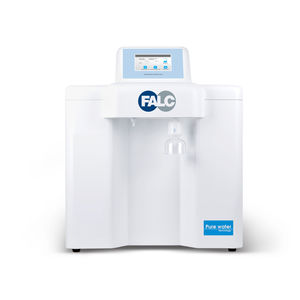
- Metrology - Laboratory
- Laboratory Equipment
- Laboratory water purification unit
- FALC Instruments S.r.l.
- Company
- Products
- Catalogs
- News & Trends
- Exhibitions
Laboratory water purification unit BASIC-Q 30 - LT/Hreverse osmosisASTM IIdeionizer
Add to favorites
Compare this product
Characteristics
- Applications
- laboratory
- Options
- reverse osmosis, deionizer, ASTM II, ASTM III
Description
BASIC Q is a combined system producing reverse osmosis and deionized/pure water, designed for generic laboratory applications. Its external structure enables to use the instrument as a bench-top or a wall-mounted one. TDS tester helps the user in measuring conductivity during purification process.
- Automatic microcomputer controlling system, LED real-time animation mode display. Running status is showed in the LED display, such as flushing, producing water, full tank, water shortage, leakage and service.
- Power on self-test, power reset, alarm when work more than 6 hours continuously, water shortage, leakage, lowand high pressure.
- 3 procedure of the reverse osmosis membrane’s self-flushing: power on, water shortage reset and work more than 2 hours continuously, extend the life of RO membrane.
- 2 kind of installation type, Desk and wall-mounted (except for 45 series and built-in tankmodel). High-strength metal shell with powder painting technics, achieve elegant appearance and meeting GLP standard.
- Pretreatment cartridges, RO module, deionized cartridges, all designed to modularization independently, easy for maintenance and replacement.
- Tube and adapter with NSF authorization and top quality, reduce TOC level and assure ultrapure water’s quality.
- Standard pretreatment (including PP fiber, and active carbon cartridge), effectively protect RO membrane and run in low cost.
- RO module with DOW’s membrane, ensure long life, stable operation and high desalinization rate.
- Precision mixed resin cartridge, combine high pure water quality and low running cost.
Catalogs
Other FALC Instruments S.r.l. products
Water Purification systems
Related Searches
- Furnace
- Chamber furnace
- Chiller
- Electric furnace
- Heat treatment furnace
- Liquid chiller
- Water chiller
- Laboratory furnace
- Laboratory shaker
- Incubator
- Laboratory incubator
- Digital laboratory shaker
- Stainless steel chiller
- Water purification unit
- Digital incubator
- Retort
- Magnetic laboratory shaker
- Benchtop laboratory shaker
- Vertical refrigerator
- Mechanical laboratory shaker
*Prices are pre-tax. They exclude delivery charges and customs duties and do not include additional charges for installation or activation options. Prices are indicative only and may vary by country, with changes to the cost of raw materials and exchange rates.





